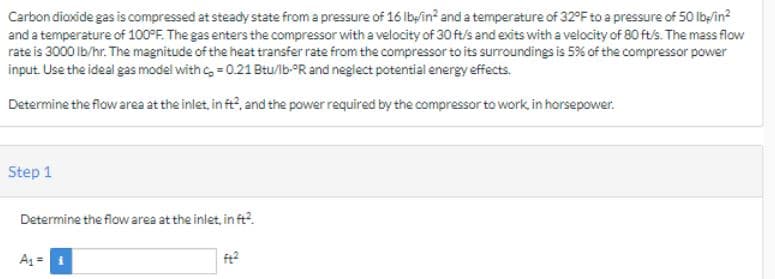Carbon dioxide gas is compressed at steady state from a pressure of 16 lb/in² and a temperature of 32°F to a pressure of 50 lb/in² and a temperature of 100°F. The gas enters the compressor with a velocity of 30 ft/s and exits with a velocity of 80 ft/s. The mass flow rate is 3000 lb/hr. The magnitude of the heat transfer rate from the compressor to its surroundings is 5% of the compressor power input. Use the ideal gas model with c = 0.21 Btu/lb-ºR and neglect potential energy effects. Determine the flow area at the inlet, in ft², and the power required by the compressor to work, in horsepower. Step 1 Determine the flow area at the inlet, in ft². A₁ = ft²
Carbon dioxide gas is compressed at steady state from a pressure of 16 lb/in² and a temperature of 32°F to a pressure of 50 lb/in² and a temperature of 100°F. The gas enters the compressor with a velocity of 30 ft/s and exits with a velocity of 80 ft/s. The mass flow rate is 3000 lb/hr. The magnitude of the heat transfer rate from the compressor to its surroundings is 5% of the compressor power input. Use the ideal gas model with c = 0.21 Btu/lb-ºR and neglect potential energy effects. Determine the flow area at the inlet, in ft², and the power required by the compressor to work, in horsepower. Step 1 Determine the flow area at the inlet, in ft². A₁ = ft²
Elements Of Electromagnetics
7th Edition
ISBN:9780190698614
Author:Sadiku, Matthew N. O.
Publisher:Sadiku, Matthew N. O.
ChapterMA: Math Assessment
Section: Chapter Questions
Problem 1.1MA
Related questions
Question
T-11

Transcribed Image Text:Carbon dioxide gas is compressed at steady state from a pressure of 16 lb/in² and a temperature of 32°F to a pressure of 50 lb/in²
and a temperature of 100°F. The gas enters the compressor with a velocity of 30 ft/s and exits with a velocity of 80 ft/s. The mass flow
rate is 3000 lb/hr. The magnitude of the heat transfer rate from the compressor to its surroundings is 5% of the compressor power
input. Use the ideal gas model with c = 0.21 Btu/lb-ºR and neglect potential energy effects.
Determine the flow area at the inlet, in ft², and the power required by the compressor to work, in horsepower.
Step 1
Determine the flow area at the inlet, in ft².
A₁ =
ft²
Expert Solution
This question has been solved!
Explore an expertly crafted, step-by-step solution for a thorough understanding of key concepts.
Step by step
Solved in 5 steps with 5 images

Knowledge Booster
Learn more about
Need a deep-dive on the concept behind this application? Look no further. Learn more about this topic, mechanical-engineering and related others by exploring similar questions and additional content below.Recommended textbooks for you

Elements Of Electromagnetics
Mechanical Engineering
ISBN:
9780190698614
Author:
Sadiku, Matthew N. O.
Publisher:
Oxford University Press

Mechanics of Materials (10th Edition)
Mechanical Engineering
ISBN:
9780134319650
Author:
Russell C. Hibbeler
Publisher:
PEARSON

Thermodynamics: An Engineering Approach
Mechanical Engineering
ISBN:
9781259822674
Author:
Yunus A. Cengel Dr., Michael A. Boles
Publisher:
McGraw-Hill Education

Elements Of Electromagnetics
Mechanical Engineering
ISBN:
9780190698614
Author:
Sadiku, Matthew N. O.
Publisher:
Oxford University Press

Mechanics of Materials (10th Edition)
Mechanical Engineering
ISBN:
9780134319650
Author:
Russell C. Hibbeler
Publisher:
PEARSON

Thermodynamics: An Engineering Approach
Mechanical Engineering
ISBN:
9781259822674
Author:
Yunus A. Cengel Dr., Michael A. Boles
Publisher:
McGraw-Hill Education

Control Systems Engineering
Mechanical Engineering
ISBN:
9781118170519
Author:
Norman S. Nise
Publisher:
WILEY

Mechanics of Materials (MindTap Course List)
Mechanical Engineering
ISBN:
9781337093347
Author:
Barry J. Goodno, James M. Gere
Publisher:
Cengage Learning

Engineering Mechanics: Statics
Mechanical Engineering
ISBN:
9781118807330
Author:
James L. Meriam, L. G. Kraige, J. N. Bolton
Publisher:
WILEY